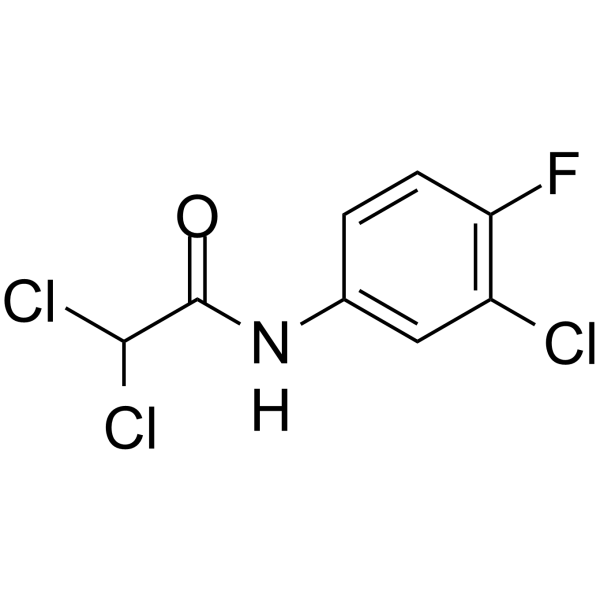| Cas No.: | 349106-80-5 |
| Chemical Name: | LDCA |
| SMILES: | FC1=C(Cl)C=C(NC(C(Cl)Cl)=O)C=C1 |
| Formula: | C8H5Cl3FNO |
| M.Wt: | 256.49 |
| Purity: | >98% |
| Sotrage: | 2 years -20°C Powder, 2 weeks 4°C in DMSO, 6 months -80°C in DMSO |
| Description: | LDCA is a dual-hit metabolic modulator and inhibits LDH-A enzyme activity to stimulate apoptosis in the malignant population. LDCA can be used for the research of oncogenic progression. |
| In Vivo: | LDCA (2 mg/kg, iv., the 6th day, once) is used in combination with doxorubicin thwarts tumor growth kinetics to restrain oncogenic progression, thus accentuating survival in the model of murine melanoma[1]. Animal Model: melanoma tumor model[1] Dosage: 2 mg/kg Administration: 2 mg/kg, iv., the 6th day, once Result: Significantly increased mice survivability combination with doxorubicin, and relieved mice tumor necrosis phenomena. |
| In Vitro: | LDCA is used in combination with doxorubicin synergistically enhances the growth inhibition and induces mitochondria-mediated apoptosis by recruiting the caspase cascade, restricting migration, and obviating the clonogenic outgrowth potential of melanoma cells[1]. Cell Viability Assay[1] Cell Line: B16-F10 cells Concentration: 2-100 μM Incubation Time: 72 h Result: Arrested cell growth with a dose-dependent cytotoxic effect and had a strong synergism with LDCA. Apoptosis Analysis[1] Cell Line: B16-F10 cells Concentration: 20 μM Incubation Time: 24 h Result: Resulted in 15% death when cells exposed to LDCA and caused 40% melanoma cell death combination synergistically with doxorubicin. Immunofluorescence[1] Cell Line: B16-F10 cells Concentration: 20 μM Incubation Time: 16 h Result: Demonstrated that combination with doxorubicin resultantly affected cellular morphology with condensed and fragmented nuclei. Cell Migration Assay [1] Cell Line: B16-F10 cells Concentration: 20 μM Incubation Time: 16 h Result: Signicantly limited the migratory potential in the B16-F10 cells. |
| References: | [1]. Saha, Suchandrima, et al. The dual-hit metabolic modulator LDCA synergistically potentiates doxorubicin to selectively combat cancer-associated hallmarks. RSC Advances, 7(84), 53322–53333. doi:10.1039/c7ra08625c. |

 DC Chemicals' products qualify for U.S. tariff exemptions. We guarantee no price increases due to customs duties and maintain stable supply, continuing to deliver reliable research solutions to our American clients.
DC Chemicals' products qualify for U.S. tariff exemptions. We guarantee no price increases due to customs duties and maintain stable supply, continuing to deliver reliable research solutions to our American clients.





















